If you have read a Spider-Man comic or watched any version of the Spider-Man movies of the past couple decades, then you have heard about the Daily Bugle. Since I have written a few posts about Spider-Man, I thought it would be good to take some time with a central part of Peter Parker’s life. (If you haven’t read any previous posts, check out these posts about Spider-Man, his villains, and his love life.) Imagine a bustling New York City skyscraper, humming with the buzz of reporters, the clatter of typewriters, and the hurried steps of interns. This is The Daily Bugle, not just any old newspaper office, but a central fixture in the web of stories that encompass Spider-Man’s world.
At the heart of The Daily Bugle’s narrative is Peter Parker, the man behind the mask and the lens. Peter’s role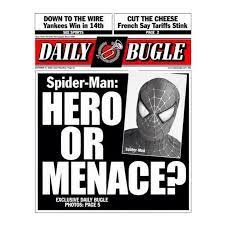 as a freelance photographer for The Bugle serves as his direct line to the public, painting Spider-Man either as a hero or a vigilante, depending largely on The Bugle’s editorial stance that day.
as a freelance photographer for The Bugle serves as his direct line to the public, painting Spider-Man either as a hero or a vigilante, depending largely on The Bugle’s editorial stance that day.
We’re going to dive into the relationship of Peter Parker and J. Jonah Jameson, the Bugle’s editor-in-chief, who has a knack for being both a thorn in Peter’s side and a comedic goldmine. Their exchanges aren’t just about negotiating the price for photos; they’re about the broader public perception of superheroes – and in this case, Spider-Man.
While the newspaper played a major role in Peter’s life, the scenes that involve The Daily Bugle also reflects the ethical quandaries and societal attitudes towards superheroes. Through headlines and articles, it serves as a mirror to the community’s fears, aspirations, and epic tales of triumph and tragedy.
Peter Parker’s Dual Life: Snapping Photos for The Bugle
Imagine trying to juggle being a full-time student, a caring nephew, boyfriend, a superhero, and a freelance photographer. That’s the daily grind for Peter Parker, our friendly neighborhood Spider-Man. I have said from my very first post about Marvel superheroes, that the authors wanted to present superheroes with problems. Peter Parker’s life is full of problems; and while working for the Daily Bugle gave him much needed cash, it also was the source of many problems. Selling photos to The Daily Bugle isn’t just a job; it’s a strategic play. Peter uses his unique position to capture Spider-Man in action — actually, his own actions — crafting his narrative in a city that’s unsure whether to cheer or fear him.
The act of photographing Spider-Man, however, does more than just pay the rent. It’s a subtle nod to the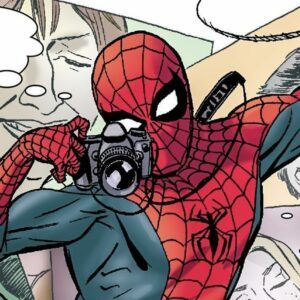 importance of media in shaping public perception. Through his lens, Peter provides proof of Spider-Man’s heroics, countering The Bugle’s smear campaigns. This task demands a careful dance, balancing risk and anonymity, as a single slip could lead to his unmasking.
importance of media in shaping public perception. Through his lens, Peter provides proof of Spider-Man’s heroics, countering The Bugle’s smear campaigns. This task demands a careful dance, balancing risk and anonymity, as a single slip could lead to his unmasking.
Selling these snapshots often leads to comedic exchanges with the miserly J. Jonah Jameson. When the 2002 movie with Tobey Maguire came to theaters, J. K. Simmons became the face of JJJ. Simmons appearance perfectly mirrored the comics’ rendering of the Daily Bugle editor with his mustache and flattop haircut. He played the part so well and was so much fun, that to this day, I still hear Simmons’s voice when I read a Spider-Man comic. The interactions between Parker and JJ shed light on Peter’s resilience and resourcefulness. Despite Jameson’s notorious penny-pinching, Peter has become adept at negotiating, knowing the competitive tension with other publications can swing a bargain in his favor.
Yet, these photos are more than mere merchandise — they represent the precarious line Peter walks between his dual identities. Every time he hands over film to The Bugle, he risks exposure. And it’s not just Jameson he has to worry about; the entire newsroom is a chessboard of relationships and rivalries that could upend his world in a flash.
Next, I’ll guide you through the tangled web of those interpersonal dynamics, including Peter’s fledgling romance with Betty Brant and the rival who would later spin tales as Venom.
Romance and Rivalry: The Daily Bugle’s Interpersonal Dynamics
In the bustling corridors of The Daily Bugle, Peter Parker’s personal life weaves a compelling thread through his professional one. Secretary Betty Brant stands out as Peter’s first serious girlfriend, her role highlighting the stark contrast between his everyday and masked personas. Betty’s affection toward Peter and her obliviousness to his secret life as Spider-Man paint a rich tapestry of youthful romance and heartache.
Betty’s connection to Peter sheds light on the intricacies of their workplace romance, a relationship constrained by Peter’s relentless dedication to his alter ego. So often, Peter wanted to share his secret identity with Betty, but was so fearful that she would reject him, if she knew he was Spider-Man. The entanglement becomes even more complex when reporter Ned Leeds enters the picture. As Peter grapples with the loss of Betty to Ned, their eventual marriage serves as a poignant testament to the human side of Peter’s life, which is so often overshadowed by his super-heroic duties.
But The Daily Bugle isn’t just a ground for unfolding love stories. It’s a backdrop against which rivalry and hidden alliances take shape. The dynamics between characters at The Bugle offer more than simple workplace drama; they reveal the deeply human struggles that underscore Peter Parker’s dual existence. Torn between his affections for Betty and his sworn duty to protect New York City, Peter’s life at The Daily Bugle becomes as intricate and tangled as the webs he spins.
As an Amazon Associate, I earn from qualifying purchases.
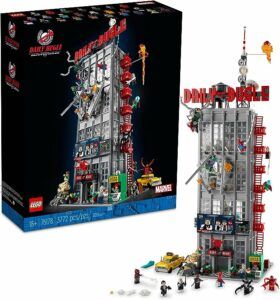
The Daily Bugle’s Cast of Characters and Their Ties to Spider-Man
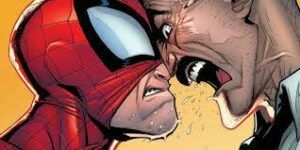
Throughout Peter’s time with the Bugle, the newsroom became a revolving door of impactful characters, each bringing their own dimension to the Spider-Man universe. One such character is Frederick Foswell, also known as ‘Patch,’ a criminal-turned-reporter with a keen eye for the truth. His attempts to link Peter Parker to Spider-Man add a layer of tension to the narrative. In Amazing Spider-Man (50-52, 1967), the criminal Kingpin attempts to taker over NYC’s criminal underworld, taking advantage of Peter’s decision to give up his secret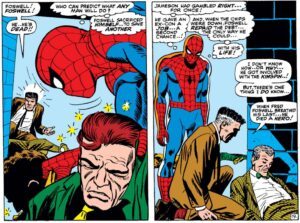 life as Spider-Man. Spidey gets back in the fight, especially after Kingpin kidnaps Jameson because of his editorials about the crime wave. Kingpin tries to drown both Jameson and the webslinger, but Spider-Man’s ingenuity rescued both of them – at least for a moment. Foswell, had considered going back to a life of crime, but turned against Kingpin when he saw the attempted murder of Jameson. Later in the story, Foswell takes a bullet for Jameson when thugs try to kill the editor. Kingpin escapes as Foswell dies. J. Jonah eulogizes his old star reporter in the Daily Bugle.
life as Spider-Man. Spidey gets back in the fight, especially after Kingpin kidnaps Jameson because of his editorials about the crime wave. Kingpin tries to drown both Jameson and the webslinger, but Spider-Man’s ingenuity rescued both of them – at least for a moment. Foswell, had considered going back to a life of crime, but turned against Kingpin when he saw the attempted murder of Jameson. Later in the story, Foswell takes a bullet for Jameson when thugs try to kill the editor. Kingpin escapes as Foswell dies. J. Jonah eulogizes his old star reporter in the Daily Bugle.
J. Jonah Jameson’s role at The Daily Bugle can’t be overstated. His fiery editorials and fervent declarations that Spider-Man is a criminal have shaped public opinion in the comics for decades. His hatred for superheroes, especially Spider-Man, drives many of the plotlines, and his editorial tirades have sold countless papers. Throughout Marvel history, we see the evolution of Jameson’s character, particularly after Peter’s identity reveal, shows a pathway to redemption and unlikely alliances.
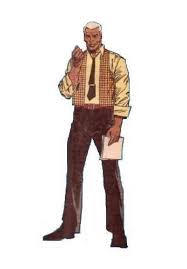 In the halls of The Daily Bugle, amidst the hard-hitting headlines, stands Joseph ‘Robbie’ Robertson. He serves as a voice of reason against Jameson’s vendetta. His representation as one of the first serious black supporting characters in comics broke barriers. More than that, Robbie’s persistent objectivity and compassion create a moral touchstone within the organization, reminding us that integrity still has a place in the hustle of the newsroom.
In the halls of The Daily Bugle, amidst the hard-hitting headlines, stands Joseph ‘Robbie’ Robertson. He serves as a voice of reason against Jameson’s vendetta. His representation as one of the first serious black supporting characters in comics broke barriers. More than that, Robbie’s persistent objectivity and compassion create a moral touchstone within the organization, reminding us that integrity still has a place in the hustle of the newsroom.
Now, let’s talk about the rivalry that fueled one of the most compelling narratives in the Spider-Man saga. Enter Eddie Brock, a character whose envy of Peter Parker would lead to explosive consequences. Brock becomes a staff reporter – the very position Peter coveted – setting the stage for animosity that would birth one of Spider-Man’s greatest nemeses: Venom. This twist in the tale reminds us that sometimes our mightiest foes originate not from distant planets or scientific mishaps, but from the cubicles next to us. Suffice to say for now, that the Bugle was the launching place for this battle with Venom. We will no doubt cover this rivalry in more depth in later posts, so you will need to bookmark this site and check back!
As you can see, the characters of The Daily Bugle are integral to the fabric of Spider-Man’s world. They offer not only a backdrop for his heroics but also intricate storylines that explore the interplay between personal ambition, morality, and the ever-present question of identity. As we venture into the reverberations of Peter’s identity reveal, keep in mind how each of these characters – whether ally or adversary – has been touched by the web of Spider-Man’s double life.
The Reveals and Repercussions of Spider-Man’s Identity
So there you have it, the twists and turns of Spider-Man’s identity within the walls of The Daily Bugle have been nothing short of astonishing. When Peter Parker first revealed himself to Jameson as Spider-Man during the ‘Civil War’ story arc, the world of The Daily Bugle was turned upside down. Yet, the impact of that moment paled in comparison with the ‘One More Day’ event, where the slate was wiped clean.
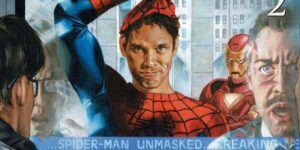
In my opinion, these pivotal moments showcase the transformative power of secret identities in superhero narratives. They’re not just plot points; they also deeply affect the relationships between characters and intimately shape the course of their lives. For Jameson, his reactions to the revelations about Spider-Man shifted from outright hostility to, eventually, an unexpected alliance.
That’s the beauty of the Spider-Man series. It’s a web of interconnected lives where individual actions ripple throughout the community at The Daily Bugle and beyond. Peter’s choices, especially regarding his dual identity, don’t only impact his role as Spider-Man but also the lives of those around him.
Peter’s relations with all the people in the newsroom, help us with understanding the burden of secrets and the consequences when they come to light. The writers behind Spider-Man have masterfully used The Daily Bugle as a stage to explore themes of trust, responsibility, and the age-old adage that “with great power comes great responsibility.”
Choose something that resonates with you from these stories. Perhaps it’s the importance of integrity, the strength found in vulnerability, or the ever-changing dynamics of heroism. Whatever lesson you take away from Peter Parker’s journey at The Daily Bugle, know that it’s a testament to the rich storytelling that has captured fans for generations. What are your thoughts? Leave a comment below and start the discussion!
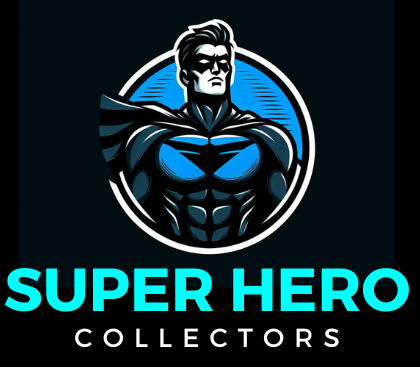
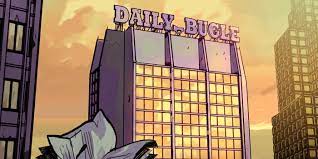
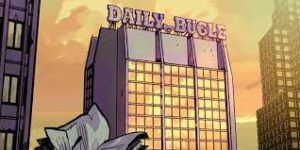
Hello Scott,
Thank you for sharing this post. One aspect that particularly resonates with me is the portrayal of The Daily Bugle as more than just a workplace; it is a microcosm of the larger societal attitudes towards superheroes and the media’s influence on public perception. Peter’s struggles to balance his dual identities and the consequences of his choices highlight themes of trust, responsibility and the weight of secrets.
Through nuanced portrayals of characters like J. Jonah Jameson, Betty Brant and Eddie Brock, the piece highlights the moral dilemmas, ethical quandaries and interpersonal dynamics that shape Peter’s journey. It was a fantastic read!
HI Starlight,
Thank you for reading and commenting. I’m glad you appreciated the deeper look into Peter’s experience at the Daily Bugle.
Please come back for more superhero content!
– Scott
Hey,
Kudos on this captivating article about Peter Parker’s relationship with the Daily Bugle. The Daily Bugle has become an iconic element of Spider-Man’s world, playing a crucial role in shaping his journey as both a superhero and a journalist. Your analysis of the complex dynamics between Peter and the newspaper, as well as the formidable J. Jonah Jameson, provides a deeper understanding of the character and his dual life. The exploration of the Daily Bugle’s impact on Spider-Man’s public image and personal struggles is truly insightful.
Well done! Looking forward to more engaging content!
Marios
Hi Marios,
Thank you for your comments. I am glad that you enjoyed the article!
– Scott
Hi, I remember reading spider man comics as a boy. He was one of my favorite superheroes. That was back in the day when cameras where low technology still. So he was able to get the best pics of the supervillains before and after he would beat them up. And nobody could figure out how lol.
Hi Jake,
Yes, it was interesting that people couldn’t figure out how he got those photos. Although, Foswell did come pretty close. He disguised himself as Patch and followed Peter, thinking that Peter was Spider-Man. When Peter realized he was being followed and possibly spotted by Patch, he faked a conversation between Peter and Spider-Man so that Foswell would think there were two men talking in the alley. Foswell then decided his hunch was wrong.
Thanks for leaving a comment. Come back for more superhero content!
– Scott
This is a captivating read on the relationship between Peter Parker and the Daily Bugle. I am surprised to find that there are so many reporters at The Daily Bugle, that are criminals that have turned. And the amount of reporters that are devoted to exposing Superman as a criminal.
It must have been quite a challenge for Peter Parker to take photographs and then juggle the act of staying unexposed, while selling them to The Daily Bugle. The relationship is indeed full of twists and nuances, that one wonders if it would be the same with modern equipment and technology.
Thank you for coming back to my site and I’m thrilled you enjoyed this post. When the Spider-Man movies came out about 20 years ago, it was somewhat modern. Peter was still a photographer. It might be really different these days though. The Tom Holland movies don’t have Peter at the Daily Bugle, although there is a DB presence.
Keep coming back!
– Scott
Hi there –
The Daily Bugle has the power to shape the narrative that Spider-Man is menacing. However, Peter Parker has thwarted their efforts by taking pictures showcasing another side. This is life imitating art and art imitating life. We see this all day in many forms, especially with social media.
It is one of the subplots one can derive from the well-crafted story of Daily Bugle and Peter Parker.
Absolutely, your observation hits the nail on the head! The dynamic between Peter Parker and the Daily Bugle, particularly through his photography, is a fascinating reflection of the symbiotic relationship between media and perception in our own world. Just as Peter uses his camera to capture the truth about Spider-Man’s heroism, individuals in our society often utilize various forms of media to shape and reshape narratives, sometimes challenging prevailing perceptions. It’s a testament to the depth of storytelling within the Marvel universe that it can so effectively mirror the complexities of our own reality. Thanks for sharing your insights!
Please come back for more superhero content!
– Scott
Engaging read! I appreciate how you dive into the intricate dynamics of The Daily Bugle, not just as Peter Parker’s workplace, but as a vital element of the larger Marvel narrative. Your discussion on how the newspaper influences public perception of Spider-Man, and Peter’s dual life struggles, really highlights the depth of these characters and their stories. Looking forward to more insights on how these relationships evolve in the Spider-Man universe!
Thank you so much for your thoughtful feedback! It’s incredibly gratifying to know that you found value in the exploration of The Daily Bugle’s role within the Marvel Universe. The dynamic between Peter Parker, Spider-Man, and The Daily Bugle is indeed rich with complexity and significance.
As we delve further into the Spider-Man universe, we’ll certainly continue to analyze the evolving relationships and how they shape not only Peter’s journey but also the broader narrative landscape. Your enthusiasm for these discussions only fuels our passion for diving deeper into the intricacies of Marvel Comics.
Stay tuned for more insights and analysis on how these relationships unfold and impact the ever-expanding world of Spider-Man! Feel free to share any specific topics or aspects you’d like us to explore further. Your engagement is what makes this journey through the Marvel Universe truly exciting!
Hi!
J.K. Simmons nails it as J. Jonah Jameson! I love that character so much, he seems so grumpy and explotative, yet when his life was in danger he did not expose who makes the Spider-man photos. His humor adds so much to the Bugle scenes. Peter and Jameson’s interactions are classic, showing how media shapes Spider-Man’s world.
Absolutely! J.K. Simmons’ portrayal of J. Jonah Jameson is iconic and truly captures the essence of the character from the comics. Jameson’s gruff exterior, combined with his underlying integrity and occasional flashes of humanity, make him a fascinating and multi-dimensional figure within the Daily Bugle scenes.
The dynamic between Peter Parker and J. Jonah Jameson is a cornerstone of Spider-Man lore, showcasing how media can both shape and distort public perception. Despite their often contentious interactions, there’s a complex mutual respect between the two characters, as evidenced by Jameson’s decision not to expose Peter as Spider-Man when his life was at risk.
Jameson’s humor, abrasive as it may be, adds a unique layer of depth to the Bugle scenes, providing both comedic relief and insight into the power dynamics at play within the newspaper industry.
It’s moments like these that highlight the nuanced relationships and social commentary present in Spider-Man comics, making them not only entertaining but also thought-provoking. Thanks for highlighting this aspect of the Spider-Man universe, and we look forward to exploring more of these dynamic interactions in future discussions!
Your fascinating post is a nostalgic historical journey on the epic Spiderman story with a focus on the more human travails of Peter Parker. The Bugle, the Characters, the reveal, etc., are all exciting angles, but what resonated with me the most was the part about the love story between Peter and Betty. With Betty, Peter had to deal with many of the same challenges he had with others regarding being Spiderman but with the added twist of genuine affection for her. Yet, he had to hide an important part of himself from her – The fact that he was Spiderman. Sadly, he eventually still lost her to Ned.
I enjoyed this post. Thank you, Scott.
Thank you for reading my post and leaving a comment! Betty’s genuine affection for Peter, coupled with her unwitting connection to Spider-Man, creates a poignant dilemma for him. The need to protect her from the dangers of his double life while yearning for a normal, fulfilling relationship is a constant source of tension for Peter. It’s a testament to his character that he navigates these challenges with such resilience and compassion, even in the face of heartbreak.
The eventual loss of Betty to Ned only deepens Peter’s sense of isolation and sacrifice. It serves as a poignant reminder of the sacrifices he must make to fulfill his responsibilities as Spider-Man, often at the expense of his own happiness.
I hope you will come back for more superhero content!
– Scott
Hi there
I couldn’t believe when this article popped up for me.
I am such a huge fan of spiderman. I regard him as the most relatable superhero in the Marvel universe. Lately I have been fully engrossed in the X-MEN 97 episodes and yesterday I learnt that the 19s spiderman – the animated series will also be getting a reboot. No one is happier than me.
You made my day with this article.
Indeed, the relationship between Peter Parker and the Daily Bugle in the Spider-Man universe is a dynamic and integral aspect of the character’s narrative. I love how your article delves into the intricate connection between Peter’s alter ego, Spider-Man, and his day job at the Bugle, exploring how it shapes his identity and moral compass. Through the lens of journalism, the Bugle serves as both a platform for truth-seeking and a vehicle for sensationalism, reflecting the complexities of media ethics and the blurred lines between heroism and vilification.
Its amazing how present day news outlets tend to do the same thing.
Peter’s interactions with J. Jonah Jameson, the Bugle’s bombastic editor, add layers of conflict and irony, highlighting the tension between public perception and personal integrity. Overall, this piece provides a compelling analysis of one of the most iconic relationships in comic book history, showcasing the enduring relevance and richness of Spider-Man’s storytelling.
Nice article and amazing, spectacular niche.
HI Troy!
It’s fantastic to hear that you enjoyed the article! Spider-Man truly holds a special place in the hearts of many, and his relatable nature undoubtedly contributes to his enduring popularity.
The parallels between Peter Parker’s experiences at the Daily Bugle and real-life media dynamics are indeed fascinating. It’s a testament to the depth of storytelling within the Spider-Man universe that it can resonate with contemporary issues, like the complexities of journalism and the struggle for truth in today’s media landscape.
And you’re absolutely right about the dynamic between Peter and J. Jonah Jameson—it’s a constant source of tension and irony that adds so much depth to Spider-Man’s narrative. Their interactions not only propel the plot forward but also serve as a reflection of the broader themes of heroism, responsibility, and the consequences of public perception.
I’m glad you found the article enjoyable and resonant. Spider-Man’s story continues to captivate audiences because it speaks to universal themes and challenges, and it’s always a pleasure to explore those themes in depth. Thank you for sharing your thoughts, and here’s to many more adventures with the web-slinger!
Since you love Spider-Man, you might also enjoy my post about his romantic life. I hope you take a look at it and leave a comment there for me! I’ll be sure to respond.
Thanks again!
– Scott
Scott, again exceptional writing and reflections. I hope you’re considering creating your own superheroes in novel form or are you a graphic artist yourself? Manga would suit you down to the ground I bet! I live in Japan so I’m surrounded by manga and anime addicts! In fact, not many people read real books here these days.
You mention that superheroes have to have lots of problems to make them compelling. I wonder if you’ve read Ayn Rand’s Atlas Shrugged and The Fountainhead? They are classics even though they were written in the middle of last century!
The Fountainhead’s hero, Howard Roarke, uncompromising architect, doesn’t seem to have any major problems in life apart from having no money or work! He’s fit and healthy and he makes his own happiness his main priority which is why he won’t work for anyone who tries to change his ideas about the project they’re paying for!
John Galt, the hero of Atlas Shrugged, remains anonymous for years and brings the whole country down with a strike. He doesn’t seem to have any problems either. He believes utterly in his ideal world and is determined to live in it, which he does in the end with the woman of his dreams!
I’d love to talk more about superheroes. But maybe you’d only interested in the Marvel Stable!
Blessings and Success.
Linden
Hi Linden! Thanks for your comments as always. I don’t really consider myself a creator in the sense of writing my own superhero stories, nor am I an artist. I just appreciate and enjoy the Marvel comics and chose them as a niche to focus on.
I have not read either of those novels, but maybe I should. Marvel certainly created their superheroes with problems and it has worked for them. By giving superheroes flaws, weaknesses, and personal struggles, writers aimed to connect with readers on a deeper emotional level. These flaws make the characters more multidimensional and realistic, allowing readers to see aspects of themselves reflected in the heroes they admire. Additionally, having problems to overcome adds depth to the storytelling and creates opportunities for character development and growth over time. Ultimately, it’s these imperfections that make Marvel superheroes not just icons, but also compelling and enduring figures in popular culture.
I have to say though that sometimes it seemed like the writers put too many problems on Spider-Man. In some issues, I thought how could anyone carry that much on his shoulders. But the more problems he had to deal with, the higher the stakes were in the story.
I hope you keep coming back for more superhero content!
– Scott
I used to love Spider-Man comics growing up, but I don’t remember the dynamics being this dramatic. I don’t remember his first girlfriend Betty either. I remember he used to take photos, but only by reading this article did I remember that he worked for the Daily Bugle.
It was a fascinating article and a great catch-up for me on my childhood memories.
Thanks for sharing your memories! It’s amazing how revisiting those childhood favorites can bring back forgotten details. Spider-Man’s world has evolved over the years, but those classic elements like his job at the Daily Bugle still resonate.
Betty Brant’s presence as Peter Parker’s first girlfriend and his role at The Daily Bugle are indeed pivotal aspects of his early adventures, yet they can sometimes fade into the background amidst the excitement of his superhero exploits.
Glad the article sparked some nostalgia for you! You might also enjoy this post I wrote about the many loves of Spider-Man.
I hope you come back to my site for more superhero content!
– Scott
Hello Scott,
The Daily Bugle is a prominent newspaper in the Marvel universe, known for its coverage of Spider-Man and its rivalry with other newspapers. Peter Parker works as a freelance photographer for the Bugle, providing them with exclusive photos of Spider-Man’s activities, despite the newspaper’s negative portrayal of the superhero. Peter Parker’s engagement with The Daily Bugle goes beyond his job as a freelance photographer. His submissions to the newspaper are a calculated move, allowing him to influence how the public views his alter ego, Spider-Man. This dynamic illustrates the delicate balance Peter must maintain between his civilian life and his responsibilities as a superhero. The Daily Bugle is a cornerstone of Spider-Man’s world, serving as a mirror to the societal impact of media, a stage for character development, and a means to explore profound themes that resonate with readers. That was a great article on Spider-man’s universe, I had a good time reading it. Thanks for sharing
HI Eric!
Thank you so much for taking the time to read and engage with my article on Spider-Man’s universe! I’m thrilled to hear that you enjoyed it. The relationship between Peter Parker, Spider-Man, and the Daily Bugle is indeed a fascinating aspect of the Marvel universe, offering layers of complexity and nuance to both the character and his world.
I’m glad you found the article insightful, and I appreciate your support. If you have any further thoughts or questions about Spider-Man or any other aspect of the Marvel universe, feel free to share them. Thanks again for reading!
I hope you will come back for more superhero content!
– Scott
This post really delves into the intricate dynamics at The Daily Bugle, highlighting its significance in Spider-Man’s world. The portrayal of Peter Parker’s struggles with his dual identity and his interactions within the newsroom is captivating. I’m particularly intrigued by the way characters like J. Jonah Jameson and Betty Brant influence Peter’s personal and professional life. The discussion about the impact of Peter’s identity reveal on the Bugle’s community is thought-provoking. It makes me wonder, how do you think Peter’s relationships with his colleagues will evolve now that his secret is out?
HI Hanna,
Thank you for your comment and question. Peter did reveal his identity in the Civil War storyline, but his secret identity was set again in the One Day More story line, where everyone’s memory about Spider-Man was erased, even Mary Jane forgot who he was and their marriage was erased. Later, he once again revealed his identity, but only to Jameson. With that reveal, Jameson swore to protect Spidey’s identity and actually became a supporter.
Please come back for more superhero content!
– Scott
You capture the world of Spider-Man brilliantly, Scott. I love this exposé on The Daily Bugle and it shows how rich this professional dynamic makes the comics, especially when it is the avenue in which Peter’s alter ego is portrayed to the world. My biggest takeaway was learning that Peter’s first girlfriend was a secretary at the Bugle, and not MJ lol.
I especially look forward to reading your deep dive into the rivalry with Eddie Brock. That’s going to be a fun one!
Cheers!
Ryan
HI Ryan!
I’m glad you enjoyed this post and thank you for commenting. Most people seem to have forgotten about Betty Brant. Peter actually had at least 2 other love interests before MJ, most notably Gwen Stacy. You can read more about these in my posts about the many loves of Spider-Man and his relationship with MJ.
Please come back for more superhero content. I hope to write about Venom and Eddie Brock soon.
– Scott
I can remember Peter Parker and the Daily Bugle from my childhood. By coming to your website you have brought out my inner child.
Before reading your article I forgot about Peter Parker being a photographer, you might find this odd that I was a photographer in the past.
Many of my superheroes from my childhood worked for a newspaper, another one that comes to mind is Clark Kent. He was a reporter instead of a photographer if you remember.
I can’t remember Peter Parker’s romance with Betty Brant, so this interested me and I learned something new that I must have forgotten.
Thank you for taking the time to write this article,
Jeff
Hi Jeff!
I am glad that I could jog your memory and bring out your inner child!
Concerning Betty Brant, you might enjoy reading my posts about the many loves of Spider-Man and his relationship with Mary Jane.
Please come back for more superhero content and share with friends and family!
– Scott
While the new Spider-Man may have better graphics and special effects, the old Spider-Man had a timeless charm and authenticity that can never be replicated. The original portrayal captured the essence of the character in a way that modern adaptations simply can’t match.
Who do you think plays the best spider man?
HI Jake,
Thank you for sharing your thoughts! There’s definitely something special about the original Spider-Man films that resonates with many fans. The timeless charm and authenticity you mentioned have left a lasting impact on the character’s legacy.
As for who plays the best Spider-Man, it’s a tough call since each actor brings something unique to the role. Tobey Maguire captured Peter Parker’s awkwardness and earnestness, Andrew Garfield brought a more modern and emotionally raw take, and Tom Holland has brilliantly portrayed the youthful and energetic side of Spider-Man. Personally, I think each of them has done an excellent job in their own right, contributing to the character’s rich history in their own ways.
Having said that, I would choose Tobey as my favorite.
Who do you think nailed the role best?
– Scott